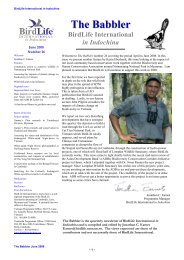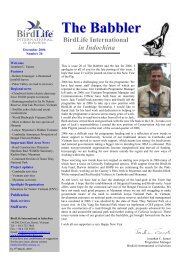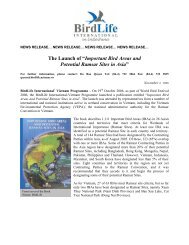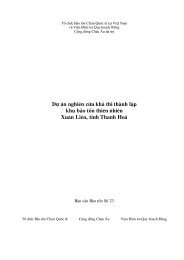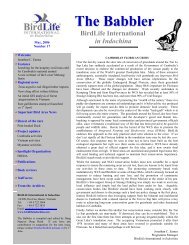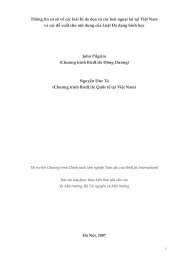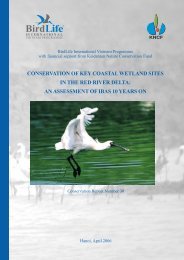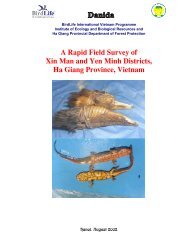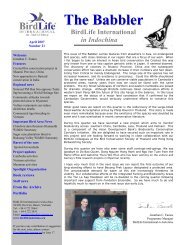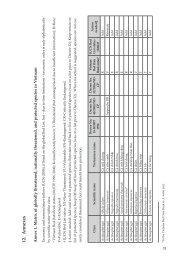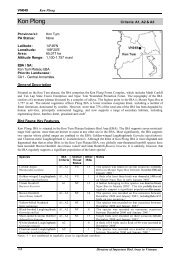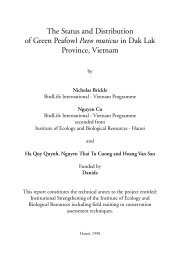A Feasibility Study for the Establishment of Xuan Lien Nature ...
A Feasibility Study for the Establishment of Xuan Lien Nature ...
A Feasibility Study for the Establishment of Xuan Lien Nature ...
You also want an ePaper? Increase the reach of your titles
YUMPU automatically turns print PDFs into web optimized ePapers that Google loves.
Section 2 - Site Features<br />
8<br />
2.8 Flora Overview<br />
The field survey recorded 560 species <strong>of</strong> vascular<br />
plants in 381 genera and 124 families (Table 3).<br />
These species include 222 timber species, 31<br />
ornamental species and 116 species with known<br />
medicinal uses (Appendix 1).<br />
The flora <strong>of</strong> <strong>the</strong> proposed nature reserve is<br />
characterised by taxa indigenous to nor<strong>the</strong>rn Vietnam and sou<strong>the</strong>rn China, such as members <strong>of</strong> <strong>the</strong><br />
Fagaceae and Lauraceae. In addition, <strong>the</strong>re are two o<strong>the</strong>r major elements to <strong>the</strong> flora. The first is an<br />
Indo-Malayan element which includes members <strong>of</strong> <strong>the</strong> Dipterocarpaceae and Combretaceae toge<strong>the</strong>r<br />
with a number <strong>of</strong> deciduous species such as Lagerstroemia tomentosa and Tetrameles nudiflora. The<br />
second is a temperate Sino-Himalayan element, characteristic <strong>of</strong> Yunnan and <strong>the</strong> Himalayan foothills;<br />
included in this element are several conifers and a number <strong>of</strong> broadleaf deciduous tree species.<br />
Of <strong>the</strong> 124 plant families represented, 12 families contain 10 or more species. These are <strong>the</strong> Euphorbiaceae<br />
(with 33 species), Lauraceae (25), Poaceae (22), Rubiaceae (20), Orchidaceae (20), Moraceae (18), Fagaceae<br />
(14), Fabaceae (14), Caesalpiniaceae (11), Asteraceae (11), Meliaceae (11) and Arecaceae (10). However, <strong>the</strong><br />
most abundant species in <strong>the</strong> study area belong to <strong>the</strong> Dipterocarpaceae, Fagaceae, Lauraceae, Magnoliaceae,<br />
Sapotaceae, Sapindaceae, Euphorbiaceae, Meliaceae, Hamamelidaceae, Cupressaceae and Poaceae. Stands<br />
<strong>of</strong> bamboo, comprising species such as Neohouzeana dulloa and Dendrocalamus patellaris, are found in<br />
areas where <strong>the</strong> <strong>for</strong>est has been very heavily disturbed. The tree flora <strong>of</strong> medium to high montane mixed<br />
coniferous and broadleaf evergreen <strong>for</strong>est is dominated by Hopea mollissima (Dipterocarpaceae); although<br />
conifers, including Fokienia hodginsii, are also present in smaller numbers. Conifers and broadleaf trees<br />
toge<strong>the</strong>r <strong>for</strong>m significant stands <strong>of</strong> mixed <strong>for</strong>est, at elevations above 1,200 m.<br />
The conservation importance <strong>of</strong> several<br />
species is notable. Of <strong>the</strong> 560 species<br />
recorded during <strong>the</strong> field survey, four are<br />
endemic to Vietnam (Cinnamomum<br />
balansae, Colona poilanei, Croton boniana<br />
and Macaranga balansae) and six are<br />
listed as threatened in <strong>the</strong> IUCN Red List<br />
<strong>of</strong> Threatened Plants (IUCN 1997)<br />
(Table 4).<br />
2.9 Vegetation Types<br />
The results from <strong>the</strong> field<br />
survey show that <strong>for</strong>est covers<br />
78.5% <strong>of</strong> <strong>the</strong> total area,<br />
although a large proportion <strong>of</strong><br />
this is bamboo <strong>for</strong>est with<br />
varying degrees <strong>of</strong> disturbance<br />
(Table 5 and Map 2).<br />
The classification <strong>of</strong> <strong>the</strong> main<br />
<strong>for</strong>est types in <strong>the</strong> study area<br />
Table 3: Floral Diversity <strong>of</strong> <strong>the</strong> <strong>Study</strong> Area<br />
Taxon Families Genera Species<br />
Lycopodiophyta 2 2 3<br />
Polypodiophyta 13 22 31<br />
Pinophyta 5 6 6<br />
Magnoliopsida 88 284 430<br />
Liliopsida 16 67 90<br />
Total 124 381 560<br />
Table 4: Globally Threatened Plants Recorded in <strong>the</strong><br />
<strong>Study</strong> Area<br />
Species Current Status<br />
as per IUCN 1997<br />
Annamocarya sinensis R<br />
Calamus tonkinensis R<br />
Dalbergia tonkinensis V<br />
Fokienia hodginsii R<br />
Madhuca pasquieri R<br />
Parashorea chinensis R<br />
Notes: V = Vulnerable; R = Rare as per IUCN (1997).<br />
Table 5: Existing Vegetation Types in <strong>the</strong> <strong>Study</strong> Area<br />
Vegetation Type Area (ha) Percent<br />
Primary Forest 1,762 7.5<br />
Elfin Forest 481 2.0<br />
Mixed Bamboo and Broadleaf Forest 2,245 9.5<br />
Pure Bamboo Forest 8,691 36.8<br />
Regenerating Forest 5,343 22.6<br />
Scrub and Grassland 4,690 19.9<br />
Agricultural Land 398 1.7<br />
Total 23,610 100.0




